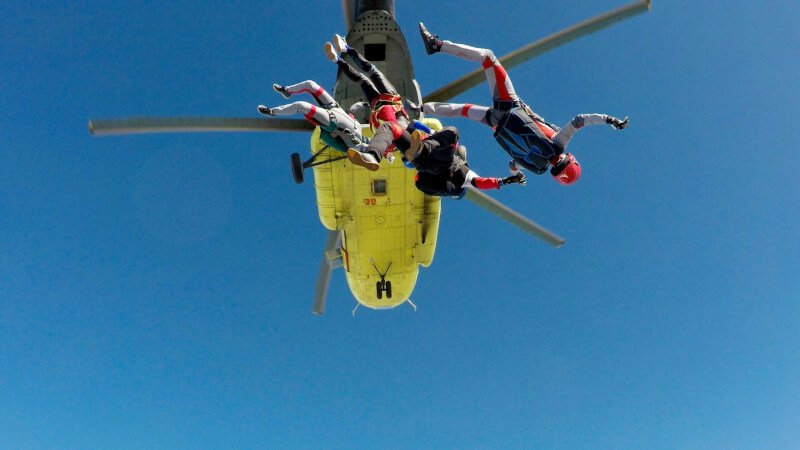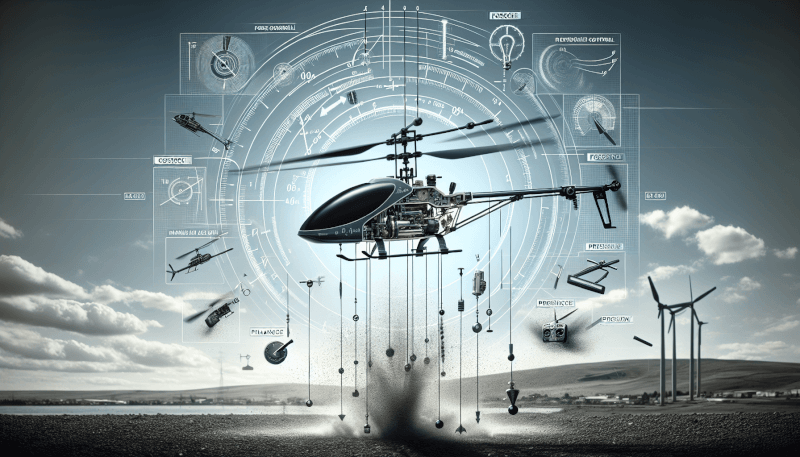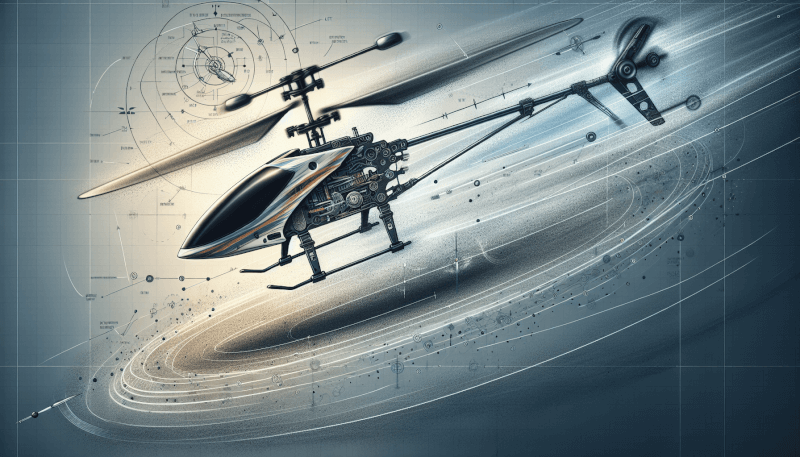Have you ever marveled at the remarkable maneuvers and flawless flight of remote-controlled helicopters? The world of RC heli flight is an intricate blend of physics and mechanics, where aerodynamic principles and technical know-how combine to create a captivating experience. In this article, we will explore the fascinating world of RC heli flight, uncovering the underlying physics and mechanics that enable these miniature aircraft to perform breathtaking stunts and navigate the skies with precision. Whether you’re a beginner or a seasoned enthusiast, understanding the science behind RC heli flight will deepen your appreciation for this exhilarating hobby. Get ready to soar to new heights as we unravel the secrets behind the physics and mechanics of RC heli flight.

1. Lift and Thrust
1.1 Airfoil and Rotor Blades
When it comes to lift and thrust, airfoil and rotor blades play a crucial role in RC helicopter flight. The airfoil shape of the blades allows for the generation of lift as the helicopter moves through the air. The curvature of the airfoil on the top surface creates a pressure differential, known as Bernoulli’s principle, which results in the upward force that lifts the helicopter off the ground.
Rotor blades are designed with a twist that helps to distribute lift evenly along their length. This twist balances the lift produced by different sections of the blades as they rotate, ensuring stability and control during flight. A well-designed airfoil and rotor blade combination is essential for achieving efficient lift and stable flight characteristics.
1.2 Collective Pitch Control
To control the lift generated by the rotor blades, RC helicopters utilize collective pitch control. This control mechanism allows the pilot to adjust the angle of attack of all the rotor blades simultaneously. By increasing or decreasing the collective pitch, you can increase or decrease the lift produced by the blades.
Collective pitch control is typically achieved through a mechanism called a swashplate. The swashplate is connected to the main rotor blades and changes their pitch angle as the pilot inputs commands from the transmitter. By manipulating the collective pitch control, you can control the vertical movement and altitude of the RC helicopter.
1.3 Main Rotor RPM
The main rotor RPM (Revolutions Per Minute) is another essential aspect of lift and thrust control in RC helicopter flight. The RPM of the main rotor directly affects the amount of lift generated by the rotor blades. Higher RPM results in increased lift, while lower RPM reduces lift.
Maintaining the appropriate main rotor RPM is crucial for stable flight. Too low of an RPM can lead to inadequate lift, causing the helicopter to descend or even lose control. On the other hand, excessively high RPM can generate excessive lift and may lead to instability or even damage the helicopter.
2. Weight and Balance
2.1 Center of Gravity
A properly balanced RC helicopter is essential for its stability and maneuverability. The center of gravity refers to the point at which the helicopter’s weight is balanced. To ensure balance, the center of gravity must be located correctly relative to the rotor blades and other components.
An RC helicopter’s center of gravity is typically located slightly forward of the main rotor mast. This positioning helps maintain stability and control during flight. If the center of gravity is too far forward or backward, it can result in unwanted flight characteristics, such as nose-heavy or tail-heavy tendencies, which can affect the helicopter’s responsiveness and overall flight performance.
2.2 Battery and Electronics Placement
The placement of the battery and other electronics in an RC helicopter also affects its weight and balance. These components need to be positioned in a way that optimizes the overall center of gravity and maintains proper weight distribution.
Placing the battery too far forward or backward can impact the helicopter’s balance and affect its flight characteristics. It’s essential to ensure that the battery is positioned in a way that achieves the desired center of gravity location and maintains stability during flight.
Electronics, such as the receiver and flight controller, should also be strategically placed to optimize weight and balance. Distributing the electronic components evenly throughout the helicopter can help maintain stability and ensure optimal performance.
3. Aerodynamics
3.1 Bernoulli’s Principle
Bernoulli’s principle, a fundamental concept in fluid dynamics, plays a significant role in the aerodynamics of RC helicopter flight. According to this principle, as the speed of a fluid (such as air) increases, its pressure decreases. This principle is critical for understanding how lift is generated by the rotor blades.
As the rotor blades spin, the airfoil shape and rotation create a pressure differential. The curved shape of the airfoil on the top surface results in faster airflow over the blade, reducing the pressure compared to the bottom surface. This pressure differential generates lift, allowing the helicopter to overcome the force of gravity and achieve flight.
Understanding Bernoulli’s principle is crucial for comprehending the mechanics behind lift generation and the design of efficient rotor blades.
3.2 Drag and Lift Forces
In addition to lift, drag forces also play a role in RC helicopter flight. As the helicopter moves through the air, various factors, such as the shape of the fuselage and rotor blades, contribute to aerodynamic drag.
Rotor blades produce both drag and lift forces. While lift allows the helicopter to remain airborne, drag opposes forward motion. The design of rotor blades aims to strike a balance between these forces, minimizing drag while maintaining stability and control.
Controlling drag is essential for optimizing efficiency and maneuverability. By reducing unnecessary drag, such as by streamlining the helicopter’s fuselage and minimizing turbulent airflow, you can enhance the overall performance and responsiveness of the RC helicopter.
4. Control Systems
4.1 Swashplate
The swashplate is a critical component of the control system in an RC helicopter. It allows for the translation of pilot input into changes in rotor blade pitch, which directly affects the helicopter’s flight characteristics.
When the pilot manipulates the control sticks on the transmitter, the input is transmitted to the swashplate. The swashplate, in turn, moves up, down, and tilts to adjust the pitch of the rotor blades. This pitch change controls the amount of lift and thrust produced by the blades, enabling the pilot to control the altitude, speed, and direction of the helicopter.
The swashplate’s complexity lies in its ability to change the pitch of all the rotor blades simultaneously while maintaining stability and precise control.
4.2 Servos
Servos are essential components that actuate the control inputs from the swashplate. They respond to commands from the transmitter and convert the electrical signals into mechanical motion.
Each servo is responsible for controlling a specific axis of movement, such as roll, pitch, or yaw. By receiving signals from the transmitter, servos can rotate the swashplate and adjust the angle of attack of the rotor blades accordingly. This precise control of the servos allows for responsive and accurate maneuvering of the RC helicopter.
The quality and reliability of servos are crucial as they directly impact the helicopter’s control responsiveness and flight performance.
4.3 Gyroscopes
Gyroscopes play a vital role in maintaining stability and orientation in RC helicopter flight. They detect changes in the helicopter’s attitude and make adjustments to the control system to counteract these changes.
By utilizing the principles of angular momentum, gyroscopes can detect deviations from the helicopter’s intended orientation and adjust the servo inputs accordingly. For example, if the helicopter starts to tip to one side, the gyroscope will automatically compensate by adjusting the swashplate inputs to level the helicopter.
Gyroscopes enhance stability and help counter external forces like wind gusts, allowing for smoother and more controlled flight.

5. Stability and Gyroscopic Precession
5.1 Gyroscopic Effect
The gyroscopic effect is an essential phenomenon that influences the stability of an RC helicopter. It occurs due to the rotational inertia of the main rotor blades.
When a force is applied to the rotor blades, such as when the pilot inputs a control command, the gyroscopic effect causes the helicopter to respond in a unique manner. Instead of immediately responding to the force, the helicopter experiences a delayed response and reacts in a direction perpendicular to the force.
This gyroscopic effect is known as gyroscopic precession and influences the helicopter’s stability and control. Understanding this phenomenon is crucial for pilots to anticipate and compensate for the delayed response during flight maneuvers.
5.2 Auto-rotation
Auto-rotation is a technique used in emergency situations when the main power source fails, and the helicopter needs to land safely. It takes advantage of the rotor’s ability to keep spinning even without power, utilizing stored rotational energy to slow the descent.
During auto-rotation, the pilot adjusts the collective pitch to decrease the lift generated by the rotor blades. This reduces drag and enables the helicopter to descend gradually while maintaining rotor RPM. By carefully managing the collective pitch and using the stored rotational energy effectively, the pilot can perform a controlled landing without power.
Auto-rotation is a critical skill for RC helicopter pilots to learn, as it provides a vital safety measure in case of power system failure.
6. Translational Flight
6.1 Forward Flight
Forward flight is a fundamental aspect of RC helicopter flight and involves transitioning from hovering to moving in a specific direction. To achieve forward flight, the pilot adjusts the cyclic control inputs, altering the pitch of the rotor blades throughout each rotation.
By increasing the pitch of the blades in the desired direction of travel, the helicopter generates more lift on that side, allowing it to move forward. The cyclic control mechanism allows for precise adjustment of the rotor blade pitch, enabling the pilot to control the speed and direction of forward flight.
Maintaining stability during forward flight requires continuous adjustment of the cyclic control inputs to counterbalance any forces acting on the helicopter due to wind or other external factors.
6.2 Sideways Flight
Sideways flight involves moving the RC helicopter directly to the left or right without changing its heading. Similar to forward flight, the pilot adjusts the cyclic control inputs, modifying the blade pitch to generate more lift on one side.
If the pilot wants to move the helicopter to the left, for example, he increases the pitch of the blades on the left side, creating more lift on that side and causing the helicopter to move sideways to the left. By carefully balancing the cyclic control inputs, the pilot can achieve smooth and controlled sideways flight.
Again, maintaining stability requires continuous adjustment and compensation for external forces to ensure a controlled flight path.
6.3 Hovering
Hovering is a crucial skill for every RC helicopter pilot. It refers to maintaining a stable position in the air without any forward, backward, or lateral movement. Achieving a stable hover requires precise control of the collective pitch, cyclic control inputs, and cyclic trim.
By carefully managing the collective pitch, the pilot can control the lift and balance the helicopter’s weight. The cyclic control inputs help to counteract any external forces and maintain position. Additionally, the cyclic trim allows for fine-tuning and adjustments to maintain a stable hover.
Hovering requires continuous adjustments and precise control inputs to counteract any disturbances and ensure the helicopter remains stationary in mid-air.

7. Maneuverability
7.1 Roll
Roll refers to the rotation of an RC helicopter around its longitudinal axis, causing it to tilt either to the left or to the right. This maneuver allows for changing the helicopter’s heading and turning during flight.
To initiate a roll, the pilot adjusts the aileron control inputs, altering the pitch of the rotor blades unevenly. By increasing the pitch on one side and decreasing it on the other, the lift generated varies, resulting in a rolling motion.
Precise control and coordination of aileron inputs are necessary to achieve stable and controlled rolls. Learning to execute smooth rolls adds a new level of maneuverability and excitement to RC helicopter flight.
7.2 Pitch
Pitch refers to the rotation of an RC helicopter around its lateral axis, causing it to tilt forward or backward. By adjusting the pitch control inputs, the pilot can control the helicopter’s forward or backward motion, enabling it to climb, descend, or perform various flight maneuvers.
Increasing the pitch of the rotor blades generates more lift on the helicopter’s front side, causing it to tilt forward and move in that direction. Decreasing the pitch has the opposite effect, causing the helicopter to tilt backward and move in the opposite direction.
Skillful manipulation of the pitch control allows for controlled ascent, descent, and precise maneuvering during flight.
7.3 Yaw
Yaw refers to the rotation of an RC helicopter around its vertical axis, causing it to turn to the left or right. By adjusting the rudder control inputs, the pilot can control the helicopter’s yawing motion, changing its heading and direction.
Increasing the rudder control input in one direction increases the lift on one side of the tail rotor, producing a yawing motion towards that direction. Decreasing the rudder input allows for a controlled yaw in the opposite direction.
Yaw control is crucial for changing the helicopter’s heading during flight, maintaining a specific flight path, and incorporating various flight maneuvers.
8. Power and Energy Sources
8.1 Electric Motors
Electric motors have become increasingly popular in RC helicopters due to their efficiency, power, and ease of maintenance. They provide reliable power and allow for precise control of the rotor blades, resulting in improved flight performance.
Electric motors in RC helicopters are typically brushless, offering smoother operation and longer lifespan compared to brushed motors. Brushless motors require less maintenance and provide higher torque, enabling the helicopter to perform more demanding maneuvers.
The use of electric motors also offers the benefit of quieter operation and reduced environmental impact compared to internal combustion engines.
8.2 Internal Combustion Engines
Internal combustion engines have traditionally powered RC helicopters and are still used in certain applications. These engines typically run on a fuel mixture, such as gasoline or nitro fuel, and provide high power output.
Internal combustion engines offer power and performance advantages, making them suitable for larger-scale RC helicopters or specialized applications that require extended flight times. They provide a distinct sound and a more realistic experience for those seeking a traditional helicopter flight feel.
However, internal combustion engines require more maintenance and tuning compared to electric motors, and their operation can be noisier and less environmentally friendly.
8.3 Battery Technology
In electric RC helicopters, batteries play a crucial role as the primary energy source. Advancements in battery technology have significantly enhanced the capabilities and flight times of electric-powered helicopters.
Lithium Polymer (LiPo) batteries have become the preferred choice for many RC helicopter pilots due to their high energy density, lighter weight, and higher discharge rates. LiPo batteries offer better power-to-weight ratios, allowing for increased performance and longer flight times.
However, it is crucial to handle LiPo batteries with care due to their sensitivity to improper charging or handling. Adhering to proper storage, charging, and handling procedures is essential to ensure safety and maximize the lifespan of the batteries.

9. Radio Control System
9.1 Radio Transmitter
The radio transmitter is the primary control interface between the pilot and the RC helicopter. It allows for the transmission of control inputs in the form of radio signals to the helicopter’s receiver, which actuates the control mechanisms.
Radio transmitters feature control sticks or pulleys that the pilot manipulates to send commands to the helicopter. The number of channels on a transmitter determines the level of control and capabilities, with more channels enabling greater control over various aircraft functions.
Transmitters also utilize different frequency bands, such as 2.4GHz or 72MHz. The use of 2.4GHz frequency bands has become prevalent due to their improved reliability, reduced interference, and greater range.
9.2 Receiver
The receiver in an RC helicopter is responsible for receiving the control signals from the transmitter and converting them into electrical signals for the servos, gyroscopes, and other control mechanisms.
Receivers typically feature multiple channels, corresponding to the different control inputs from the transmitter. Each channel is assigned to a specific control function, such as throttle, collective pitch, cyclic control, and rudder control.
The receiver’s reliability and responsiveness are critical for maintaining control and stability during flight. High-quality receivers establish a strong link between the transmitter and the helicopter, ensuring precise and accurate command transmission.
9.3 Remote Pilot
The remote pilot or operator plays a pivotal role in controlling and maneuvering the RC helicopter during flight. With the help of the radio transmitter, the pilot provides inputs that influence the helicopter’s movements and behavior.
The pilot’s skill, experience, and understanding of the helicopter’s capabilities and limitations are crucial for safe and enjoyable flying. With practice, pilots can develop the necessary control techniques and flight maneuvers to explore the full potential of RC helicopter flight.
It is essential for remote pilots to adhere to safety guidelines and regulations, maintain situational awareness, and continuously improve their flying skills through practice and education.
10. Safety and Regulations
10.1 Flight Restrictions
When flying RC helicopters, it is vital to be familiar with and comply with any flight restrictions or regulations in your area. Certain areas, such as airports, public parks, or residential neighborhoods, may have restrictions or limitations on RC helicopter flight for safety reasons.
Understanding and respecting airspace regulations ensures the safety of other people, property, and aircraft. Be aware of any designated fly zones or no-fly zones in your vicinity and always fly in approved areas when practicing or enjoying your RC helicopter.
10.2 Maintenance and Inspections
Regular maintenance and inspections are essential for safe and reliable RC helicopter flight. Inspect your helicopter before every flight, checking for any loose or damaged parts, signs of wear and tear, or any potential issues that may affect flight performance.
Routine maintenance tasks may include cleaning, lubrication, and adjustments to the control mechanisms or rotor blades. Regularly review the manufacturer’s guidelines and recommendations for maintenance intervals and procedures.
Taking care of your RC helicopter ensures its optimal performance, longevity, and helps prevent any unexpected issues during flight.
10.3 Insurance Requirements
Depending on the region or country you reside in, there may be specific insurance requirements for operating RC helicopters. Insurance coverage can protect you financially in the event of an accident or damage caused by the RC helicopter.
Consider obtaining liability insurance coverage for your RC helicopter to mitigate any potential risks and ensure peace of mind while flying. Consult with insurance providers specializing in RC aviation to understand the coverage options and requirements applicable to your situation.
By adhering to safety guidelines, complying with regulations, and maintaining adequate insurance coverage, you can enjoy RC helicopter flight responsibly while minimizing potential risks and ensuring a safe flying experience.
In conclusion, understanding the physics and mechanics of RC helicopter flight is essential for safe and enjoyable flying. Factors such as lift and thrust, weight and balance, aerodynamics, control systems, stability and gyroscopic precession, translational flight, maneuverability, power sources, radio control systems, and safety and regulations all contribute to the complete understanding of RC helicopter flight. By expanding your knowledge in these areas and continuously improving your flying skills, you can fully appreciate the intricacies and excitement of piloting an RC helicopter. Happy flying!



